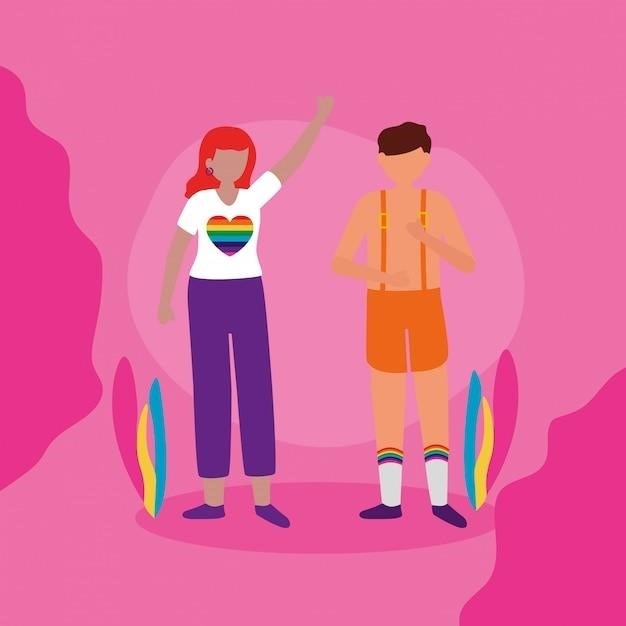Bisexuality in Adolescence⁚ A Comprehensive Overview
This article explores the complex world of bisexuality in adolescence, providing a thorough overview of the topic. We delve into the understanding of sexual orientation, the spectrum of attraction within bisexuality, and the unique experiences of bisexual adolescents. The article also examines the social and cultural influences that shape adolescent experiences with sexual orientation, including the challenges faced by bisexual youth. We discuss mental health considerations and offer strategies for supporting bisexual adolescents, highlighting the importance of resources and advocacy. Finally, we provide insights for further research into this crucial area of adolescent development.
Introduction
Adolescence is a pivotal period in human development, marked by significant physical, emotional, and social changes. During this time, individuals grapple with identity formation, including their sexual orientation. While discussions about sexuality often center around heterosexual and homosexual identities, the experiences of bisexual adolescents are often overlooked and misunderstood. This article aims to shed light on the complexities of bisexuality during adolescence, addressing the unique challenges, social pressures, and mental health considerations faced by this group. By providing a comprehensive overview of bisexuality in adolescence, we hope to foster understanding, empathy, and support for bisexual youth.
Understanding Sexual Orientation
Sexual orientation refers to an individual’s enduring pattern of emotional, romantic, and/or sexual attraction to others. It is a fundamental aspect of a person’s identity and is distinct from other components of sexuality, such as biological sex, gender identity, and gender expression. While often categorized as heterosexual (attraction to the opposite sex), homosexual (attraction to the same sex), or bisexual (attraction to more than one gender), sexual orientation exists on a spectrum, with individuals experiencing attraction in various ways and degrees. Understanding the complexities of sexual orientation is crucial for fostering a more inclusive and accepting environment, particularly for adolescents who are navigating their own identities.
Bisexuality⁚ A Spectrum of Attraction
Bisexuality encompasses a wide range of experiences, defying simplistic definitions. While often understood as attraction to both men and women, it’s important to recognize that bisexuality extends beyond this binary. Some individuals may feel attraction to individuals of multiple genders, including transgender, genderfluid, or non-binary individuals. The intensity and nature of attraction can vary significantly among bisexual individuals; Some may experience equal attraction to both genders, while others may have a stronger preference for one gender over another. Furthermore, attraction can fluctuate over time, meaning that a person’s experiences with bisexuality might evolve throughout their life. The fluidity and diversity of bisexual experiences emphasize the importance of embracing a spectrum of attraction, moving beyond rigid labels to better understand and support bisexual individuals.
The Adolescent Experience
Adolescence is a crucial period for the development of sexual identity, making it a particularly significant time for bisexual individuals. This stage is marked by intense exploration and self-discovery, often accompanied by heightened sensitivity to social norms and expectations. Bisexual adolescents may face unique challenges as they navigate their attraction to multiple genders, often grappling with societal pressures to conform to heteronormative ideals. The exploration of sexual identity can be further complicated by societal misconceptions and limited visibility of bisexual experiences, leading to feelings of isolation and confusion. Adolescents may struggle to find accurate information about bisexuality, leading to internalized stigma and self-doubt. It is crucial to create environments where bisexual adolescents feel safe to explore their identities, receive support, and find resources that validate their experiences.
Social and Cultural Influences
Bisexual adolescents navigate a world shaped by societal norms and cultural influences that often reinforce heteronormativity, making it challenging for them to fully embrace their identities. These influences can manifest in various forms, from the limited representation of bisexuality in media and popular culture to the prevalence of stereotypes and misconceptions about bisexual individuals. The “invisibility” of bisexual experiences can contribute to feelings of isolation and invalidation, as adolescents may struggle to find relatable role models or accurate information about bisexuality. Furthermore, cultural biases and prejudice can create a hostile environment for bisexual youth, leading to discrimination and social exclusion. These factors can impact their sense of belonging, self-esteem, and mental well-being, emphasizing the need for inclusive and supportive social and cultural environments for bisexual adolescents to thrive.
Challenges Faced by Bisexual Adolescents
Bisexual adolescents often face a unique set of challenges stemming from societal misconceptions and limited understanding of bisexuality. They may experience internalized biphobia, questioning their validity as bisexual individuals and struggling to reconcile their attraction to multiple genders with societal expectations. The “bi-erasure” phenomenon, where bisexual experiences are overlooked or dismissed, can further isolate and marginalize bisexual youth. Additionally, they may encounter external discrimination and prejudice, facing stereotypes that portray bisexuality as a phase or a lack of commitment. This can lead to feelings of invisibility, isolation, and difficulty finding acceptance within their social circles. Bisexual adolescents may also struggle with navigating the complexities of coming out, fearing rejection from family, friends, or romantic partners. The challenges they face highlight the need for increased awareness, understanding, and support to create a more inclusive and affirming environment for bisexual youth.
Mental Health Considerations
The challenges faced by bisexual adolescents can significantly impact their mental health; Internalized biphobia and societal discrimination can lead to feelings of shame, anxiety, and depression. Bisexual youth may experience heightened stress and difficulty coping with the emotional burden of navigating their identity in a world that often fails to understand or validate their experiences. They may also be at increased risk for substance abuse, self-harm, and suicidal ideation. The lack of representation and positive role models within their communities can further contribute to feelings of isolation and loneliness. It is crucial to recognize that mental health challenges are not inherent to bisexuality but rather a consequence of the social and cultural stigma that surrounds it; Creating supportive and affirming environments, promoting education and awareness, and providing access to mental health resources are essential steps in addressing the mental health needs of bisexual adolescents.
Supporting Bisexual Adolescents
Supporting bisexual adolescents requires a multifaceted approach that addresses their unique needs and challenges. Creating safe and inclusive environments is paramount. Schools, families, and communities must actively promote acceptance and understanding of sexual orientation diversity. Open and honest conversations about bisexuality, free from stigma and judgment, are essential. Educating individuals about the complexities of bisexuality and dispelling myths can foster empathy and respect. Providing access to mental health services, including counseling and support groups, is crucial for addressing potential mental health concerns. Connecting bisexual adolescents with LGBTQ+ organizations and resources empowers them to find a sense of belonging and access vital information. Furthermore, encouraging self-expression and affirming their identities can bolster their self-esteem and resilience. By creating supportive networks, promoting understanding, and providing necessary resources, we can help bisexual adolescents thrive and reach their full potential.
Resources and Advocacy
Access to accurate information and resources is vital for bisexual adolescents navigating their identity and experiences. Organizations like the Human Rights Campaign (HRC) and GLAAD offer valuable resources, including educational materials, support groups, and advocacy initiatives. These organizations work to combat discrimination and promote understanding of LGBTQ+ issues, including bisexuality. Online platforms and social media groups provide safe spaces for connection, information sharing, and peer support among bisexual youth. Additionally, online resources, such as websites dedicated to LGBTQ+ health and well-being, offer guidance on topics such as sexual health, mental health, and coming out. Advocacy groups play a crucial role in advocating for policies that protect and support bisexual youth. They work to ensure access to inclusive education, healthcare, and legal protections. By advocating for equality and raising awareness, these groups contribute to creating a more accepting and supportive society for bisexual adolescents.

Bisexuality in adolescence is a complex and multifaceted experience that requires understanding, support, and acceptance. Adolescents exploring their bisexuality often face unique challenges related to societal norms, limited representation, and internalized biases. It is crucial to acknowledge the diversity within the bisexual community and recognize that bisexual youth may experience attraction in various ways. Creating a safe and supportive environment for bisexual adolescents is essential for their well-being and healthy development. This includes providing access to accurate information, promoting open dialogue, and challenging societal biases. By fostering understanding, promoting acceptance, and advocating for inclusive policies, we can create a world where bisexual adolescents can thrive and embrace their authentic selves.
Further Research
Further research on bisexuality in adolescence is crucial to deepen our understanding of this diverse group. Areas requiring further investigation include the long-term impact of internalized binegativity on mental health outcomes, the effectiveness of different interventions for supporting bisexual youth, and the role of cultural context in shaping adolescent experiences with bisexuality. Additionally, research is needed to examine the prevalence of bisexual identity among adolescents across different cultural and socioeconomic backgrounds. Further exploration of the intersectionality of bisexuality with other identities, such as gender identity, race, and socioeconomic status, is essential to develop more inclusive and nuanced interventions. By investing in research that centers the voices and experiences of bisexual youth, we can work towards creating a more equitable and supportive world for all adolescents exploring their sexual orientation.
